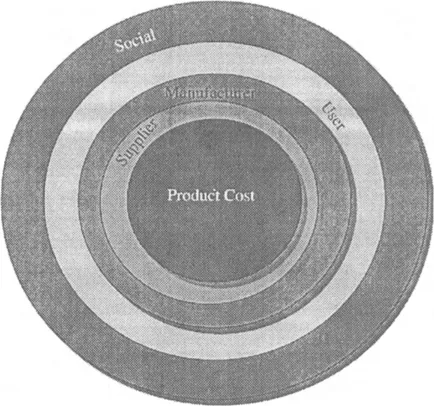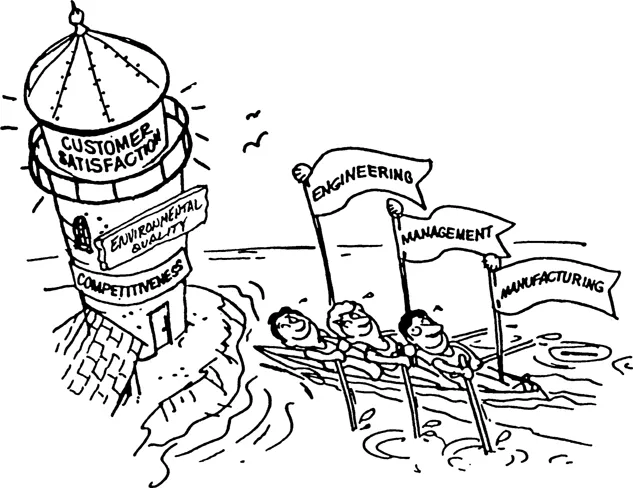![]()
1 INTRODUCTION
The trend in U.S. industry, and the U.S. EPA, is toward preventing wastes before they are created instead of treating or disposing of them later. An example of the interest by the government is the U.S. Army Strategic Defense Command regulation USASDCR 200-2. This regulation requires an environmental impact analysis of weapon systems from design through use and disposal. The advancement of ISO 14000 is another example of companies, technical associations, and governments trying to organize a voluntary approach to waste prevention, In international markets this is extremely important. European countries have “green” requirements on products and are expanding the requirements at a rapid rate. This is evident in Germany, The Netherlands, Denmark, Scandinavian countries, and Great Britain. Asian countries, such as Singapore, have also initiated a similar set of programs. Part of a green product and green manufacturing is understanding the total impact and cost the product has on the environment. This means evaluating the total life cycle of a product from raw materials and manufacturing through distribution, use, and ultimate reuse/disposal (Figure 1-1). That a product has a finite life cycle implies that there are associated costs that go along with it. Examples of these costs are shown below:
• Design costs
• Stocking/handling costs
• User/operating costs
• Disposal costs
• Manufacturing costs
• Shipping/transportation costs
• Reuse/recycle costs
• Compliance/licensing costs
This illustrates that the impact on the environment and life cycle costs are larger than just the manufacturing costs (Figure 1-2). Understanding the life cycle costs will assist the company in finding ways to reduce postmanufacturing costs. Reducing these costs will also help in reducing the environmental impacts. While the concept of life cycle has existed for more than 20 years, there has been no comprehensive procedure that will facilitate understanding the process and provide the basic tools needed for a company to conduct the analysis in a rigorous yet cost-effective manner. This book would provide the industrial user with the necessary background, simple and effective tools, instruction, and examples to conduct environmental life cycle analysis on their products in a cost-effective manner.
Figure 1-1 Environmental life cycle analysis stages.
Figure 1-2 Life cycle cost circle.
Figure 1-3 Team approach to environmental quality and customer satisfaction. (From Waste Minimization as a Strategic Weapon, Ciambrone, D. F., CRC/Lewis Publishers, Boca Raton, FL, 1995.)
Environmental life cycle analysis is a systematic tool used for assessing the environmental impacts associated with a specific product or service. The application of the process, and associated waste minimization practices by management, design, and manufacturing (Figure 1-3) can also lead to better and less-polluting products that are less expensive and provide a marketing edge over the competition. The importance of the life cycle analysis goes beyond the marketability of the product being studied. In Chapter 10, it will be shown that the outcome of the life cycle analysis can have a positive impact on human health, the ecosystem, and natural resources (Figure 1-4).
Figure 1-4 Life cycle goals.
![]()
2 OVERVIEW
BRIEF HISTORY
Environmental issues have gained greater public and legal scrutiny in the past 25 years. The public has become more aware and interested in the consumption of goods and services and their impact on the natural resources and the quality of the environment. A nationwide study in 1991 by the Wall Street Journal/NBC found that 80% of Americans considered themselves environmentalists. In the past 12 years, an increasing number of firms have been shifting their focus from remediation of pollutants to pollution prevention. This has included “green” design activities and replacing some materials and manufacturing processes with more environmentally friendly ones. These efforts on behalf of the companies involved have drastically reduced the levels of industrial pollution. The impact, or “MANPRINT", on the environment by the products use and disposal has not usually been included in the environmental assessment of the pollution prevention program.
Industry is realizing that the impact their products have on the environment does not start and end with the manufacture of the product. The impact a product has on the world starts with the design and ends at the ultimate disposal of the product after its useful life. What considerations are made during the design phase of a product affects the whole life cycle. It is important to not have solely a means of determining the environmental impacts of the manufacturing process but what impact the product will have on the environment and its ability to be recycled.
While reducing the impact a company and its products make on the environment is a good idea, the costs associated with minimizing these impacts must be considered. Everything a company does has an effect on its bottom line. Environmental compliance has been considered a cost of doing business, and staying out of jail. The increased use of waste minimization programs has not only reduced the costs of compliance (which goes up over time) but has lowered the costs of producing the products. In a number of cases the quality of the product has improved. This in itself reduces costs and improves competitiveness of the products. In the global marketplace, the reduced impact of products on the environment has serious marketing impact. Sound environmental practices will result in designs that meet or exceed the requirements of the countries where they will be sold. This is especially true in Europe where manufacturers retain responsibility for disposal of their products after retired by their users. There are laws on the books in Germany that require the removal of unnecessary packaging from products and lets merchants pay for the disposal of this waste. It is reasonable therefore to consider the total impact on the environment of a product and plan means of reducing that impact during the planning and design phase of the product life cycle.
Life cycle analysis had its beginnings in the 1960s. One of the first publications on the subject was presented at the World Energy Conference in 1963 by Harold Smith. He reported on his calculation of cumulative energy requirements for the production of chemical intermediates and product. Later in the 1960s global modeling studies were published in The Limits to Growth (Meadows et al., 1972) and A Blueprint for Survival (Club of Rome). These studies involved the demand for finite raw materials and energy resources. In 1969 researchers did a study for The Coca-Cola Company that was to be the foundation for current methods of life cycle analysis. In the early 1970s other companies in the U.S. and Europe performed similar life cycle analyses. The process of quantifying the use of resources and the release of products into the environment in the U.S. became known as Resource and Environmental Profile Analysis (REPA). In Europe it was called Econobalance. During the late 1970s to early 1980s interest in REPA waned in the U.S. However, interest in the process increased in Europe. The Green Movement, especially the formation of Green political parties in Europe, reawakened interest in the subject. When solid waste became an issue worldwide in the late 1980s, the life cycle analysis technique reemerged as a tool for analyzing environmental problems. The Iraqi invasion of Kuwait in 1990 and once again the prospect of oil shortages as well as concerns for solid waste disposal reemphasize the need for environmental life cycle analysis tools.
The concept of a life cycle as used here simply means that the inputs to the “cycle” (energy, materials, etc.) and outputs (energy, waste materials, products, etc.) are evaluated for each step of a product or process life. The cycle begins at conception of the product or process and completes with the recycle/disposal of the product and its constituents (Figure 2-1). In the past, companies have used the “cradle to grave” analysis as indicated. During the 1995 to 1997 time frame, some companies have used the “fence line approach". This approach assesses the impacts associated with the product on site and disregards off-site functions. While this approach does not provide valuable information needed to assess the total impact, it will provide insights into the operations at the site and their impact on the environment. It can also point out areas for environmental...




